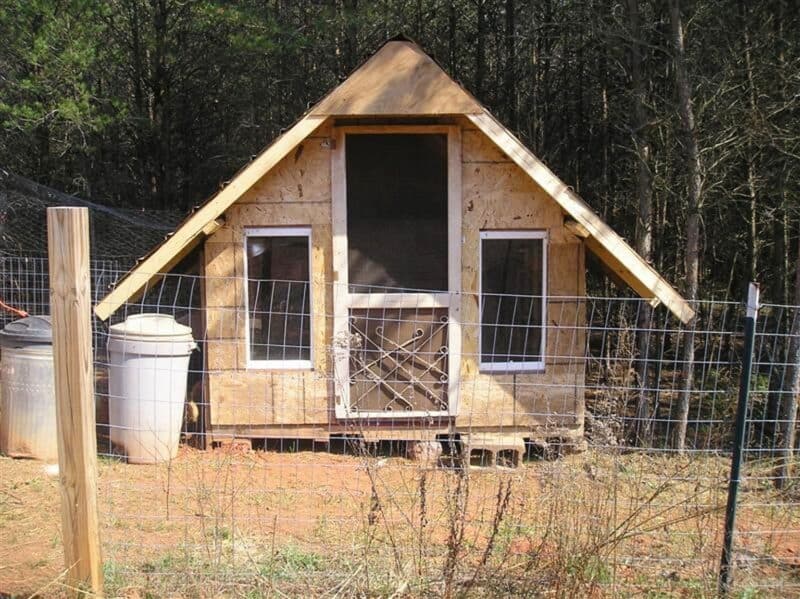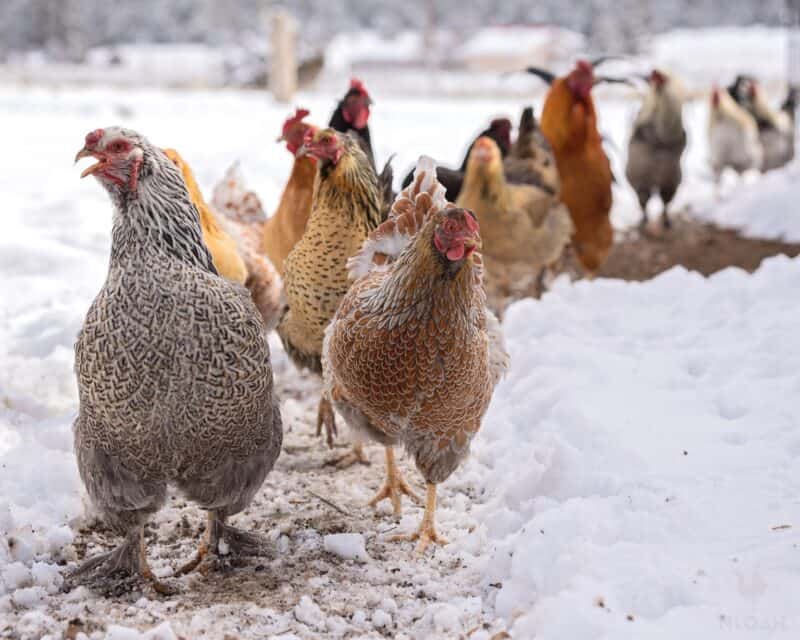No matter what kind of breed you have, where you live, or how you raise your chickens, one thing they will always need is a coop. The coop is where chickens go to sleep at night and stay safe from predators.

Your chickens will probably be spending a lot of time in the coop if you live anywhere with a harsh winter, and this naturally begs an important question: do chicken coops really need to be heated?
No, chicken coops won’t require heat if properly designed, maintained and insulated (unless they’re drafty).
Rest assured that most chickens do just fine in cold weather, and have excellent insulation from their feathers, but drafty coops or coops in extremely cold environments might need supplemental heating. Of course, fixing those drafts should be done first.
The issue of heating is a contentious one among chicken keepers…
Some folks heat the coops when winter rolls around no matter what, wanting their birds to stay comfortable at all times.
Others maintain that chickens have excellent cold weather adaptation thanks to their feathers and high metabolism.
Which is correct? Are both groups right? Is there an easy answer when it comes to coop heating? Yes, there is, but it takes a little explanation to get there. I’ll tell you all about it below.
Most Chicken Breeds Handle Cold Weather Fine
The first thing we need to clear up is that, yes indeed, most chickens handle cold weather just fine.
When you think about it, this makes sense: a chicken’s feathers, so long as they’re intact and dry, are excellent at blocking out wind and also insulating them by trapping warm air against their bodies.
This acts like a natural down parka that you or I would wear to beat the chill!
Feathers even have a degree of natural waterproofing that helps chickens deal with a certain amount of humidity and a little bit of rain or snow.
Combined with a chicken’s naturally high metabolism, so long as they are dry, healthy and out of contact with the snow or other cold surfaces most will stay warm enough to survive and be reasonably comfortable.
These benefits are amplified when chickens huddle close together, and amplified further when they’re inside a snug coop that will stay even warmer and keep wind and snow off of them.
A Well-Designed and Maintained Coop Will Stay Warm Enough
A typical chicken coop, assuming it is properly constructed and reasonably well maintained, is more than enough to keep your average chicken safe and reasonably happy during an average winter.
And when I say average winter, let’s just assume that temperatures are around freezing, snow, the whole nine yards.
As mentioned, chickens can stay toasty warm on their own given just a few advantages, and when you put a flock of them inside the small space of a coop, they can heat it right up themselves with nothing but their body heat.
However, a poorly designed chicken coop, or one in a bad state of repair can let too much of the outside elements in, and that means your chickens might be getting too cold.
How Cold is Too Cold for Chickens?
So just how cold is too cold for chickens? It’s a surprisingly difficult question to answer, and it depends on the breed, the overall weather conditions and to a degree even the individual chicken.
Some chicken keepers assert that their flock is completely happy, safe and snug in temperatures exceeding 20 °F below zero (-29 °C).
Others have reported cold-related injuries in temperatures right around or even slightly above freezing. How can this be? Why the discrepancy?
Simply, some breeds are more cold hardy, and even the most cold-adapted breeds will suffer if they are in damp conditions, in direct contact with snow, missing feathers, suffering from illness, or lacking energy due to inadequate calorie intake.
The good news is it is easy enough to find out if your birds are warm enough inside the coop: on a cold winter day, when your chickens are inside the coop, open it up and step inside or stick your head in.
If the coop seems significantly warmer than the outside, but not muggy, your birds are probably okay.
Don’t be afraid to touch them and feel their bodies: if they are warm and dry beneath their feathers, they are doing great.

Look for Hypothermia and Frostbite
All that being said, you should always keep a sharp eye out for signs of cold stress and cold injury in your chickens.
Hypothermia and frostbite can easily kill or maim chickens, but thankfully both are easy to spot.
If you feel your chickens and their skin feels cool or anything but toasty warm, they might be suffering from hypothermia.
Look for unblinking, glazed or staring eyes and a general lack of activity. You’ll need to quickly warm up the affected bird using a warm blanket, warm dry bedding and preferably a warm space to rest in.
Frostbite is more obvious, and typically affects the chicken’s comb, wattles and toes. Discoloration, a stiff or bloodless appearance, and obvious blackening or tissue death are all indicators.
Any breeds that have particularly exposed toes or large and prominent combs and wattles are disproportionately vulnerable.
If you see any of these signs in your chickens, or they have experienced them in previous winters, your coop is not warm enough.
How Can You Keep a Coop Warm?
Warming up a coupe is easily done by using heaters or by winterizing the coop. More about winterizing in just a minute, but for now let’s look at the heaters.
Specialized Coop Heaters
Specialty chicken coop heaters are usually the ideal solution. Most are designed to be much safer than traditional heaters and heat lamps, and they can often easily be integrated into the wall of a coop and provide enhanced safety features.
Solar Heaters
Solar heaters are another popular and safe option for heating a chicken coop, and also eco-friendly.
These heaters use sunlight, as one would think, and turn it into heat which is then slowly radiated into the interior of the chicken coop.
The obvious problem with solar heaters is that a lack of sunlight, particularly common during the winter, greatly reduces their efficiency or even renders them inoperative.
Heat Lamps
Last, we have the old standby, heat lamps. Heat lamps must be placed with extreme care and securely mounted because they are big fire hazards and responsible for many coop fires.
But, used with modern safety features and an eye toward temperature control they can be an inexpensive and still effective solution to heating a coop.
Temperature Control is Mandatory
Whatever kind of heater you decide to use, it must have built-in temperature control, or you must equip it with a separate device for the same purpose.
A temperature controller will turn the heater on and off as necessary to maintain a constant temperature in the coop.
Good ones can also prevent accidents by shutting off the heater when detecting a spike in temperature.
Safety is a Must with Any Coop Heater!
Safety is the obvious issue when using any chicken coop heater, and particularly a concern with the old-fashioned heat lamps.
Ground cover or bedding, feathers, tip-over accidents and more can all lead to fires which will quickly immolate the coop and kill your birds horribly.
Even heaters with the best modern safety features are still responsible for many accidents.
Also, you must secure the heater from investigation by the birds- and protect the birds from the heater when they do decide to investigate it!
Securely enclosing and anchoring cords is a must if they cannot be hidden, and all heaters must have tip-over protection and safety cages to keep chickens from coming too close to hot parts.
When in Doubt, Try Winterizing the Coop First
If the inside of your coop is too cold, assess why and then attempt repairs or improvements before you resort to a heater. Keep the following in mind:
Dry, Ventilated, Insulated
A good coop will be dry, ventilated and insulated. Chickens that get wet will lose the natural insulation ability of their feathers, and also be more vulnerable to frostbite.
A coop must be ventilated to keep moisture levels down, and reduce the buildup of ammonia from the droppings of your chickens.
Lastly, the better insulated a coop is the more protection chickens will have from drafts, and they will also enjoy a better benefit from accumulated body heat.
Wide Roost Bar
Also, a wider-than-normal roost bar is a good idea for any chicken coop that is going to house your flock through a seriously harsh winter.
Narrow roost bars mean that a chicken’s toes might curl all the way around the bar, and be outside the protective envelope of their fluffed-up feathers.
It’s a small thing, but this might make their feet more vulnerable to frostbite if the interior of the coop is very cold.
After doing all of this, recheck the interior on a cold day and see if it isn’t greatly improved. Once your chickens are inside, you’ll probably find you won’t need a heater at all!
Tom has lived and worked on farms and homesteads from the Carolinas to Kentucky and beyond. He is passionate about helping people prepare for tough times by embracing lifestyles of self-sufficiency.
